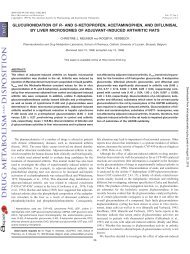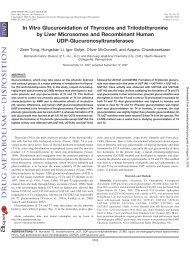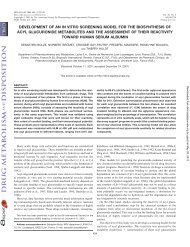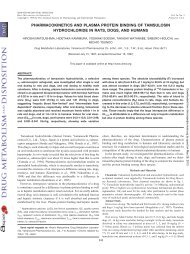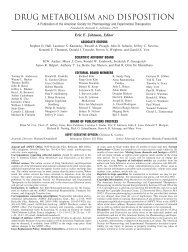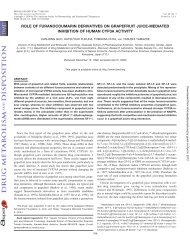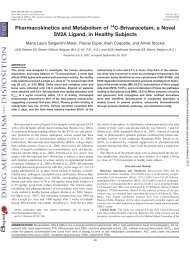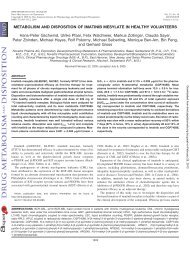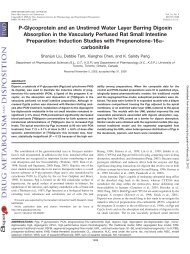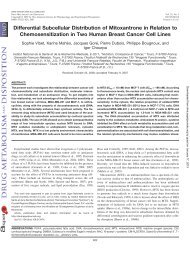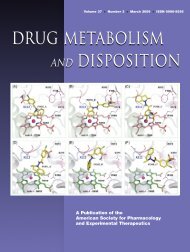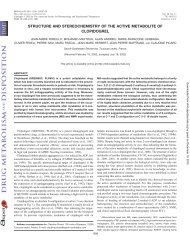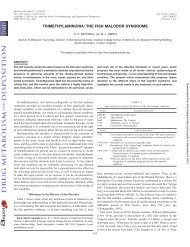Influence of the Cyp1B1 L432V Gene Polymorphism and - Drug ...
Influence of the Cyp1B1 L432V Gene Polymorphism and - Drug ...
Influence of the Cyp1B1 L432V Gene Polymorphism and - Drug ...
You also want an ePaper? Increase the reach of your titles
YUMPU automatically turns print PDFs into web optimized ePapers that Google loves.
<strong>Cyp1B1</strong> <strong>L432V</strong> GENE POLYMORPHISM AND <strong>Cyp1B1</strong> mRNA EXPRESSION<br />
incidence <strong>of</strong> head <strong>and</strong> neck squamous cancer (Ko et al., 2001), lung<br />
cancer susceptibility (Wenzlaff et al., 2005), renal cancer (Sasaki et<br />
al., 2004), <strong>and</strong> colorectal cancer (Fritsche et al., 1999) has been<br />
reported. The ability to identify individuals at highest risk <strong>of</strong> cancer is<br />
important for cancer control strategies. The fact that 20% <strong>of</strong> lung<br />
cancer cases occur in nonsmokers is <strong>of</strong>ten attributed to a combination<br />
<strong>of</strong> genetic factors (Gorlova et al., 2007). Therefore, we investigate <strong>the</strong><br />
functional impact <strong>of</strong> <strong>the</strong> allelic variant <strong>Cyp1B1</strong>*3 on quantitative<br />
<strong>Cyp1B1</strong> mRNA expression in a population <strong>of</strong> smokers, nonsmokers,<br />
<strong>and</strong> ex-smokers in relation to <strong>the</strong>ir <strong>Cyp1B1</strong> genotypes.<br />
Materials <strong>and</strong> Methods<br />
Subjects. The study population consisted <strong>of</strong> 365 whites. Volunteers were<br />
personnel <strong>of</strong> <strong>the</strong> Universitätsklinikum Giessen <strong>and</strong> Marburg GmbH, students<br />
<strong>of</strong> <strong>the</strong> Justus-Liebig-Universität Giessen, <strong>and</strong> patients recruited at <strong>the</strong> Policlinic<br />
<strong>of</strong> <strong>the</strong> Institute for Arbeits- <strong>and</strong> Sozialmedizin, Giessen, Germany.<br />
All <strong>of</strong> <strong>the</strong> subjects included in this study were interviewed using a questionnaire<br />
to obtain information on lifestyle, including smoking habits, alcohol<br />
consumption, indoor air pollution (coal heating <strong>and</strong> cooking), eating habits,<br />
lifetime occupational history, <strong>and</strong> disease history. The group comprised 271<br />
males (mean age, 56 years; range, 20–91 years) <strong>and</strong> 93 females (mean age, 40<br />
years; range, 16–82 years). The subgroup smokers (n � 107) was defined as<br />
people who smoke daily; nonsmokers (n � 103) were defined as people who<br />
had never smoked; <strong>and</strong> ex-smokers (n � 155) were defined as people who had<br />
quit smoking at least 3 months ago. The ethics committees <strong>of</strong> <strong>the</strong> University<br />
Hospital, Giessen, Germany approved <strong>the</strong> study.<br />
Real-Time Polymerase Chain Reaction <strong>and</strong> <strong>Polymorphism</strong> Detection.<br />
Blood samples (approximately 3 ml) were obtained from all <strong>the</strong> subjects.<br />
Genomic DNA was isolated from whole blood using <strong>the</strong> versa<strong>Gene</strong> DNA<br />
Purification Kit (Gentra Systems, Minneapolis, MN). Detection <strong>of</strong> <strong>the</strong> <strong>L432V</strong><br />
polymorphism in exon 3 <strong>of</strong> <strong>the</strong> <strong>Cyp1B1</strong> gene was performed by rapid capillary<br />
polymerase chain reaction (PCR) with melting curve analysis using fluorescence-labeled<br />
hybridization probes in a LightCycler System (Roche Diagnostics,<br />
Mannheim, Germany) (Brüning et al., 1999). Both negative <strong>and</strong> positive<br />
controls were included in each PCR reaction. TIB MOLBIOL (Berlin, Germany)<br />
syn<strong>the</strong>sized <strong>the</strong> PCR primers <strong>and</strong> <strong>the</strong> fluorescent-labeled detection<br />
probes. The primers <strong>Cyp1B1</strong>-forward (5�-GAAATAAGAATTTTGCTCACT-<br />
TGC-3�) <strong>and</strong> <strong>Cyp1B1</strong>-reverse (5�-CTTAGAAAGTTCTTCGCCAATG-3�)<br />
amplify a 441-base pair fragment <strong>of</strong> <strong>the</strong> <strong>Cyp1B1</strong> gene that includes codon 432<br />
containing <strong>the</strong> sequences CTG or GTG, coding for leucine or valine, respectively.<br />
The fluorescein-labeled probe (ATGACCCACTGAAGTGACCTA-<br />
ACCC-FL) <strong>and</strong> <strong>the</strong> LC-Red640-labeled probe (LC640-AACTTTGATC-<br />
CAGCTCGATTCTTGGACAA-PH) bind to nucleotides 8123 through 8147<br />
<strong>and</strong> 8152 through 8180 within <strong>the</strong> human <strong>Cyp1B1</strong> gene (GenBank entry<br />
U56438), respectively. Therefore, <strong>the</strong> expected melting curve in a C allele will<br />
be higher than in a G allele. The samples homozygous for <strong>the</strong> C allele<br />
(<strong>Cyp1B1</strong>*1/*1) contain a single peak <strong>and</strong> a melting temperature <strong>of</strong> 63°C, <strong>and</strong><br />
samples homozygous for <strong>the</strong> G allele (<strong>Cyp1B1</strong>*3/*3) show a single peak at<br />
55°C. Heterozygous (<strong>Cyp1B1</strong>*1/*3) samples give rise to biphasic melting<br />
curves (Fig. 1). In <strong>the</strong> following <strong>the</strong> homozygous genotype <strong>Cyp1B1</strong>*1/*1 is<br />
denoted “*1/*1”; <strong>the</strong> heterozygous genotype <strong>Cyp1B1</strong>*1/*3 is denoted “*1/*3”;<br />
<strong>and</strong> <strong>the</strong> homozygous genotype <strong>Cyp1B1</strong>*3/*3 is denoted “*3/*3” (Fig. 1).<br />
The reaction mixture comprised 1� FastStart DNA Master Hybridization<br />
Probes (Roche Diagnostics), primers <strong>Cyp1B1</strong>-forward (0.55 �M) <strong>and</strong><br />
<strong>Cyp1B1</strong>-reverse (1.1 �M), sensor (0.275 �M), anchor (0.275 �M), MgCl2 (3<br />
mM), <strong>and</strong> 25 ng <strong>of</strong> genomic DNA in a 10-�l reaction mixture. PCR contamination<br />
was checked by <strong>the</strong> inclusion <strong>of</strong> a negative control. PCRs were initially<br />
denatured at 95°C for 10 min <strong>and</strong> subjected to 50 cycles <strong>of</strong> amplification with<br />
TABLE 1<br />
<strong>Cyp1B1</strong> <strong>L432V</strong> polymorphism<br />
Homozygote Wild-Type Heterozygote Homozygote Mutant<br />
Genotypes <strong>Cyp1B1</strong>*1/*1 <strong>Cyp1B1</strong>*1/*3 <strong>Cyp1B1</strong>*3/*3<br />
Nucleotides C/C C/G G/G<br />
Amino acids Leu/Leu Leu/Val Val/Val<br />
1491<br />
5 s <strong>of</strong> denaturing at 95°C, 20 s <strong>of</strong> annealing at 56°C, <strong>and</strong> 35 s <strong>of</strong> extension at<br />
72°C. The melting curve was achieved by 2sat95°C, 30 s at 40°C, <strong>and</strong> 1 s<br />
at 90°C, 0.1°C/s.<br />
RNA Extraction <strong>and</strong> Reverse Transcription. White blood cells were<br />
isolated from 10 ml <strong>of</strong> peripheral blood using Ficoll (GE Healthcare, Little<br />
Chalfont, Buckinghamshire, UK) as described by <strong>the</strong> manufacturer. Total RNA<br />
was isolated from white blood cells using a commercial RNA isolation reagent<br />
(TRI Reagent; Sigma-Aldrich, St. Louis, MO) according to <strong>the</strong> manufacturer’s<br />
instructions. Isolated RNA was resuspended in 10 �l <strong>of</strong> RNase-free water.<br />
Each sample was treated twice with 2 �l <strong>of</strong> RNase-free DNase, 1 unit/�l<br />
(QIAGEN, Valencia, CA), for 10 min at 37°C to eliminate remaining DNA.<br />
The prepared RNA was reverse-transcribed to syn<strong>the</strong>size cDNA. Reversetranscriptase<br />
reactions were performed for 1hat37°C in a final volume <strong>of</strong> 10<br />
�l using 1 �g <strong>of</strong> RNA, 500 ng <strong>of</strong> oligo(dT)15 (Promega, Mannheim, Germany),<br />
10 mM dNTPs (Fermentas Inc., Glen Burnie, MD), 8 units <strong>of</strong> RNasin<br />
(Promega), <strong>and</strong> 3 units <strong>of</strong> AMV Reverse Transcriptase <strong>and</strong> 1� AMV Reverse<br />
Transcriptase Reaction buffer (Promega).<br />
Real-Time PCR. For quantitative comparison <strong>of</strong> <strong>Cyp1B1</strong> mRNA levels<br />
real-time PCR was performed using SYBR Green fluorescence in a Light-<br />
Cycler System (Roche Diagnostics). After optimization <strong>of</strong> PCR conditions,<br />
amplification efficiency was tested in st<strong>and</strong>ard curves using serial cDNA<br />
dilutions. The correlation coefficient had to be greater than 0.9 <strong>and</strong> <strong>the</strong> slope<br />
around �3.5. Amplification specificity was checked using melting curves.<br />
Both negative <strong>and</strong> positive controls were included in each PCR reaction. All<br />
<strong>the</strong> assays were carried out three times as independent PCR runs for each<br />
cDNA sample. <strong>Gene</strong> expression was always related to expression <strong>of</strong> �-2microglobulin<br />
(B2M) as housekeeping gene, which is known to be a good<br />
choice for normalization <strong>of</strong> <strong>the</strong> expression levels <strong>of</strong> leukocytes (V<strong>and</strong>esompele<br />
et al., 2002). Calculations <strong>of</strong> expression were performed with <strong>the</strong> 2 ���CT<br />
method according to Pfaffl et al. (2001). The gene expression levels were<br />
rounded to three decimal places. The sequence <strong>of</strong> <strong>the</strong> specific primers for<br />
CYP1B1 <strong>and</strong> B2M was CYP1B1-forward (5�-AACCGCAACTTCAG-<br />
CAACTT-3�), CYP1B1-reverse (5�-GAGGATAAAGGCGTCCATCA-3�),<br />
B2M-forward (5�-ACTGAATTCACCCCCACTGA-3�), <strong>and</strong> B2M-reverse (5�-<br />
CCTCCATGATGATGCTTACA-3�). PCR reactions were carried out in a final<br />
volume <strong>of</strong> 20 �l using 1� ABsolute quantitative PCR SYBR Green capillary<br />
mixes (ABgene, Epsom, Surrey, UK), 300 nM B2M primers or 600 nM<br />
<strong>Cyp1B1</strong> primers, <strong>and</strong> 2 �l <strong>of</strong> cDNA. The PCR conditions for <strong>Cyp1B1</strong> were as<br />
follows: initial denaturation 15 min at 95°C, touchdown PCR 2 cycles <strong>of</strong> 95°C<br />
for 10 s, 67°C for 10 s, <strong>and</strong> 72°C for 25 s; 2 cycles <strong>of</strong> 95°C for 10 s, 65°C for<br />
10 s, <strong>and</strong> 72°C for 25 s; 2 cycles <strong>of</strong> 95°C for 10 s, 63°C for 10 s, <strong>and</strong> 72°C for<br />
25 s; <strong>and</strong> 45 cycles <strong>of</strong> 95°C for 10 s, 61°C for 10 s, <strong>and</strong> 72°C for 25 s. The PCR<br />
conditions for B2M were as follows: initial denaturation 15 min at 95°C <strong>and</strong><br />
PCR 55 cycles <strong>of</strong> 95°C for 10 s, 63°C for 10 s, <strong>and</strong> 72°C for 10 s.<br />
All <strong>of</strong> <strong>the</strong> measurements were made without information about <strong>the</strong> origin <strong>of</strong><br />
<strong>the</strong> samples <strong>and</strong> were performed in triplicate. After amplification reaction,<br />
products were controlled <strong>and</strong> separated on 2% agarose gels, stained with<br />
SYBR Safe, <strong>and</strong> photographed under UV illumination.<br />
Statistical Analysis. Smokers were considered current smokers at <strong>the</strong> time<br />
<strong>of</strong> blood withdrawal. Ex-smokers were all <strong>the</strong> individuals who were previously<br />
smokers but had quit smoking at least 3 months before blood withdrawal.<br />
Information was collected on <strong>the</strong> usual number <strong>of</strong> cigarettes smoked per day,<br />
<strong>the</strong> age at which <strong>the</strong> subject started smoking, <strong>and</strong>, if <strong>the</strong> person was an<br />
ex-smoker, <strong>the</strong> age <strong>and</strong> time at which <strong>the</strong> subject stopped smoking. One<br />
pack-year was defined as smoking 20 cigarettes daily for 1 year. All <strong>of</strong> <strong>the</strong><br />
statistical analyses were performed using <strong>the</strong> statistical s<strong>of</strong>tware package SSPS<br />
15.0 (SPSS Inc., Chicago, IL). Allelic <strong>and</strong> genotype frequencies were obtained<br />
by direct counting. Hardy-Weinberg equilibrium was assessed by a � 2 test with<br />
1 degree <strong>of</strong> freedom. Results are expressed as mean � S.E.M. Means in<br />
Downloaded from<br />
dmd.aspetjournals.org by guest on February 12, 2013



